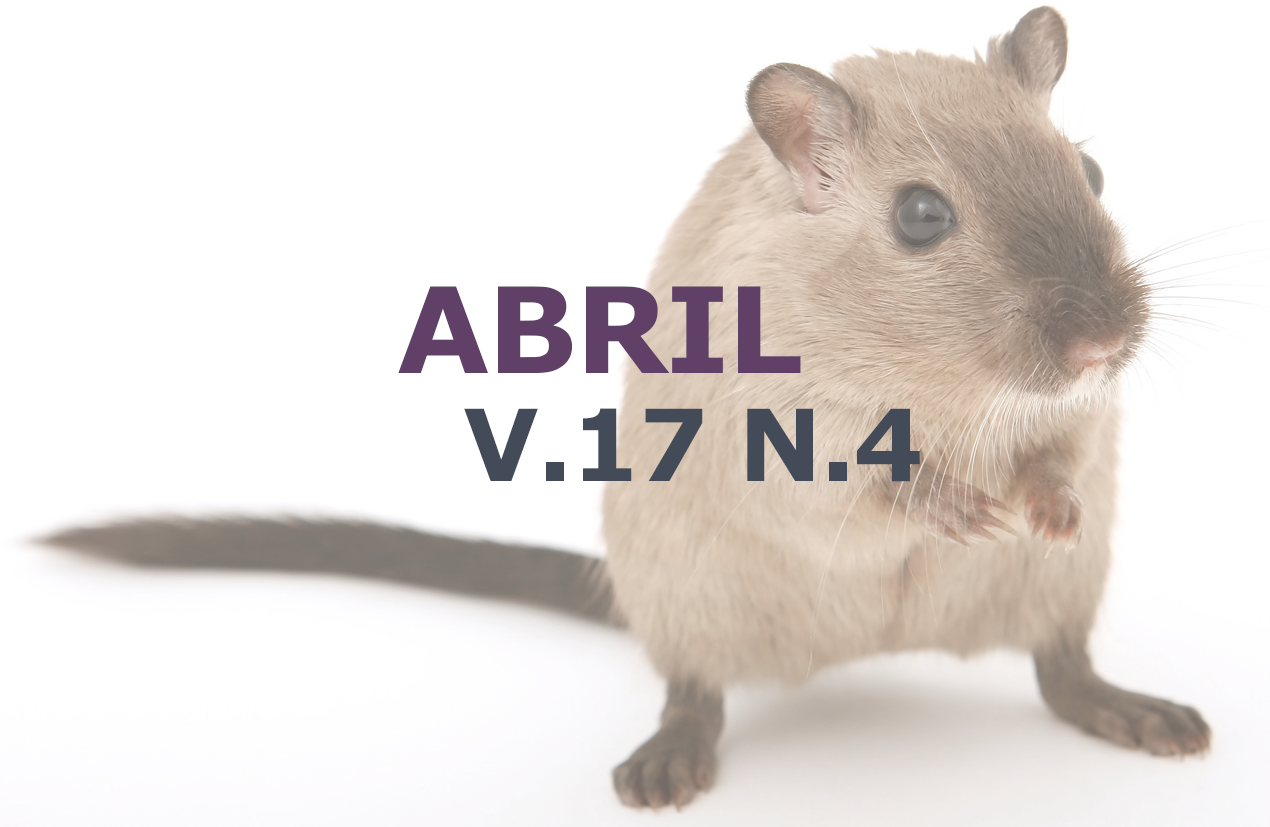Use of medicinal cannabis in the treatment of feline inflammatory bowel disease: Case report
DOI:
https://doi.org/10.31533/pubvet.v17n4e1373Keywords:
Cannabis, inflammatory bowel disease, treatmentAbstract
Inflammatory bowel disease (IBD) in cats occurs due to an exacerbated immune response to the presence of antigens in the gastrointestinal mucosa. This condition is one of the main causes of vomiting and chronic diarrhea in small animals, showing no sexual predisposition and being observed in middle-aged cats. The most used treatment is immunosuppressive therapy which, ideally, is gradually reduced until completely suspended. However, some animals may need this therapy for a longer period, which can cause a series of side effects. Thinking of a less aggressive therapeutic alternative, this article aims to report the case of a six-year-old male Persian cat diagnosed with IBD who was referred for medical cannabis treatment. The animal arrived with a history of diarrhea with hematochezia and emesis after an attempt to decrease the dose of budesonide. Budesonide was replaced by prednisolone, and cannabis oil was prescribed with gradual evolution of the administered dose, until the complete cessation of clinical signs. After adjusting the doses, it was possible to observe clinical improvement of the feline which, in addition to having no more gastrointestinal symptoms, was less fearful of situations that, previous to the cannabis therapy, generated behavioral changes. Observing the evolution of the clinical condition and the animal's well-being, it is concluded that the use of medical cannabis in the treatment of IBD was effective.
References
Baron, J. A., Folan, R. D., & Kelley Junior, M. K. (1990). Ulcerative colitis and marijuana. Annals of Internal Medicine, 112(6), 471–471. https://doi.org/10.7326/0003-4819-76-3-112- 6-471_1.
Birchard, S. J., & Sherding, R. G. (2008). Manual Saunders: clínica de pequenos animais. In Ed. Roca (Vol. 3).
Brutlag, A., & Hommerding, H. (2018). Toxicology of marijuana, synthetic cannabinoids, and cannabidiol in dogs and cats. Veterinary Clinics: Small Animal Practice, 48(6), 1087–1102. https://doi.org/10.1016/j.cvsm.2018.07.008.
Cital, S., & Highston, L. (2021). Cannabinoids in cats: use and misuse. The International Society of Feline Medicine Journal for Veterinary Nurses and Technicians, 7(5), 121–130.
Correia-da-Silva, G., Fonseca, B. M., Soares, A., & Teixeira, N. (2019). Canábis e canabinóides para fins medicinais. Revista Portuguesa de Farmacoterapia, 11(1), 21–31.
Couch, D. G., Maudslay, H., Doleman, B., Lund, J. N., & O’Sullivan, S. E. (2018). The Use of Cannabinoids in Colitis: A Systematic Review and Meta-Analysis. Inflammatory Bowel Diseases, 24(4), 680–697. https://doi.org/10.1093/ibd/izy014
Ettinger, S. J., Feldman, E. C., & Cote, E. (2017). Textbook of Veterinary Internal Medicine-eBook. Elsevier Health Sciences.
Gouvêa, F. N., Pennachi, C. S., Assaf, N. D., Arantes, E. A. L., Stefaniszen, A. G., Vieira, E. M., Genari, V., Guimarães-Okamoto, P. T. C., & Melchert, A. (2020). Doenças inflamatória intestinal em cães - Relato de casos. Ars Veterinaria, 36(4), 332–336. https://doi.org/10.15361/2175-0106.2020v36n4p332-336.
Hornby, P. J., & Prouty, S. M. (2004). Involvement of cannabinoid receptors in gut motility and visceral perception. British Journal of Pharmacology, 141(8), 1335–1345. https://doi.org/10.1038/sj.bjp.0705783.
Kulpa, J. E., Paulionis, L. J., Eglit, G. M. L., & Vaughn, D. M. (2021). Safety and tolerability of escalating cannabinoid doses in healthy cats. Journal of Feline Medicine and Surgery, 23(12), 1162–1175. https://doi.org/10.1177/1098612X211004215
Ligresti, A., Petrocellis, L., & Marzo, V. (2016). From phytocannabinoids to cannabinoid receptors and endocannabinoids: Pleiotropic physiological and pathological roles through complex pharmacology. Physiological Reviews, 96(4), 1593–1659. https://doi.org/10.1152/physrev.00002.2016
Little, S. E. (2016). O gato: medicina interna. Editora Roca.
Marques, M. L. O., Fernandes, L. D., Simone, N. T., Caldeira, C. S., & Carneiro Junior, W. A. (2021). Doença inflamatória intestinal: Revisão. PUBVET, 15(12), 1–10. https://doi.org/10.31533/pubvet.v15n12a977.1-10.
Nelson, R., & Couto, C. G. (2015). Medicina interna de pequenos animais (3.ed.). Elsevier Brasil.
Norsworthy, G. D., Crystal, M. A., Grace, S. F., & Tilley, L. P. (2004). O paciente felino. São Paulo: Roca, 3, 300.
Pesce, M., Esposito, G., & Sarnelli, G. (2018). Endocannabinoids in the treatment of gastrointestinal inflammation and symptoms. Current Opinion in Pharmacology, 43, 81–86. https://doi.org/10.1016/j.coph.2018.08.009.
Silva, A. K., Janovik, N., & Oliveira, R. R. (2020). Canabidiol e seus efeitos terapêuticos. In A. Diehl & C. Pillon (Eds.), Maconha: prevenção, tratamento e políticas públicas (pp. 110–112). Artmed Editora.
Silver, R. J. (2019). The endocannabinoid system of animals. Animals, 9, 2–15. https://doi.org/10.7551/mitpress/10457.003.0003.
Stanzani, A., Galiazzo, G., Giancola, F., Tagliavia, C., Silva, M., Pietra, M., Fracassi, F., & Chiocchetti, R. (2020). Localization of cannabinoid and cannabinoid related receptors in the cat gastrointestinal tract. Histochemistry and Cell Biology, 153(5), 339–356. https://doi.org/10.1007/s00418-020-01854-0
Tartakover Matalon, S., Azar, S., Meiri, D., Hadar, R., Nemirovski, A., Abu Jabal, N., Konikoff, F. M., Drucker, L., Tam, J., & Naftali, T. (2021). Endocannabinoid Levels in Ulcerative Colitis Patients Correlate With Clinical Parameters and Are Affected by Cannabis Consumption. Frontiers in Endocrinology, 12(August), 1–12. https://doi.org/10.3389/fendo.2021.685289
Tilley, L. P., & Smith Junior, F. W. (2014). Consulta veterinária em 5 minutos. Manole Ltda
Downloads
Published
Issue
Section
License
Copyright (c) 2023 Carla Lemos Novais, Veridiana Soares Roberto, Regina Maria Nascimento Augusto Blaitt, Elisângela França de Oliveira

This work is licensed under a Creative Commons Attribution 4.0 International License.
Você tem o direito de:
Compartilhar — copiar e redistribuir o material em qualquer suporte ou formato
Adaptar — remixar, transformar, e criar a partir do material para qualquer fim, mesmo que comercial.
O licenciante não pode revogar estes direitos desde que você respeite os termos da licença. De acordo com os termos seguintes:
Atribuição
— Você deve dar o crédito apropriado, prover um link para a licença e indicar se mudanças foram feitas. Você deve fazê-lo em qualquer circunstância razoável, mas de nenhuma maneira que sugira que o licenciante apoia você ou o seu uso. Sem restrições adicionais
— Você não pode aplicar termos jurídicos ou medidas de caráter tecnológico que restrinjam legalmente outros de fazerem algo que a licença permita.





